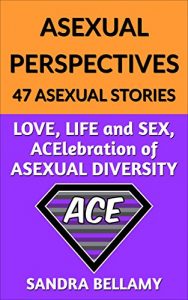 A lot of people aren’t even really aware that asexuality exists, so I have the utmost respect for Sandra Bellamy for creating a book specifically to help people understand it. Essentially, what she’s done is ask forty-six different asexual people to answer a set of twenty-odd questions so that we can get an insight into their lives and perspectives on things.
A lot of people aren’t even really aware that asexuality exists, so I have the utmost respect for Sandra Bellamy for creating a book specifically to help people understand it. Essentially, what she’s done is ask forty-six different asexual people to answer a set of twenty-odd questions so that we can get an insight into their lives and perspectives on things.
The results of this, I think, are fascinating. I’ve written before about how there are not enough asexual perspectives in the media and reading this book was enormously refreshing. There are so many different types of people, with so many different outlooks, so many different backgrounds and so many different attitudes towards love and sex. One of them said something along the lines of the asexual spectrum being as diverse and as broad as the sexual spectrum and I definitely agree.
For this reason, I think it’s something that everybody should look into. It’s important to understand other people and other perspectives. Even if you feel like you’re already completely familiar with asexuality, it’s worth reading if only because the people interviewed have had some really interesting life experiences.
Although as good as it may be, the book is not without its flaws. Sandra herself answers the same questions as everybody else at the end of the book, but her answers are all a lot longer than everybody else’s and they often felt quite ramble – y. At times, she talks about the very specific type of men she finds physically attractive and about how much she hates doing housework, two things which I don’t feel really reflect much about the asexual experience. It felt like she had just splurged out her thoughts in several run on sentences without really planning her answers.
Plus, I felt at times there was a bit of anti-sexual sentiment, suggesting that non-asexuals had less meaningful romantic relationships simply because they had sex, for example. I also felt like one or two of the questions themselves got a bit boring after a while (such as, asking people what they felt the difference between sexual arousal and desire were) and could have been replaced by questions asking people about how important friendship is to them, as I know that it is particularly important to a lot of asexuals (more so than non-asexuals) in that they use them for the emotional fulfillment others get from romantic relationships. There were a lot of little niggles like this throughout.
Overall though, I am glad that I read this and I recommend it to anybody who would like to learn more about asexuality. Sandra has definitely succeeded in giving a voice to those who need one and ultimately, that’s much more important than any of the book’s pitfalls.
Rating: 8/10
(Don’t miss today’s Finger Puppet Show!)
